Digitalis (Digitalis)
Content:
Digitalis is a herb that is also biologically referred to as digitalis. It has long been considered a full-fledged representative of the Podorozhnikov family, but earlier it was considered a typical representative of the Norichnikov family. The genus includes more than thirty different species. In nature, this plant is most often found in the Mediterranean, as well as in Europe, North Africa and Western Asia. Four types of foxglove are found in the Caucasus, and two species perfectly take root in the European part of Russia, as well as in Western Siberia. Foxglove is a plant that thrives on forest edges or clearings, as well as in meadows and among shrubs.
In this article, we will dwell in more detail on the features of digitalis, on how to grow it and transplant it. Let's touch on the aspects of caring for the plant, as well as how to propagate the foxglove. Information about the species and varieties of foxglove will be interesting, as well as about the positive and negative properties of this plant.
The article will be of interest to both experienced gardeners and those who are just starting their horticultural and floricultural activities, and therefore collects any information about such interesting plants.
Digitalis: a description of the plant and its features
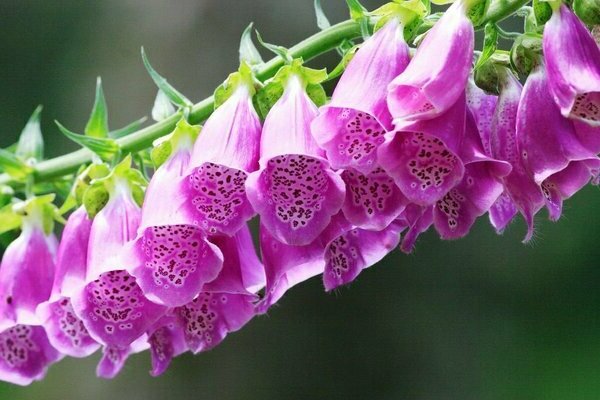
Foxglove: Photo of a plant
Foxglove is a very popular herb that is also a perennial. On the territory of the Western Mediterranean it is fashionable to find digitalis in the form of a semi-shrub, and sometimes shrub forms of the same plant are found.
The shoots of the plant are quite tough, branched, their height can vary from thirty centimeters to one and a half meters. The leaf plates are solid, greenish, can be either lanceolate or already slightly oblong in shape. They are quite sharp, they can gradually move also to the area of the bracts, which looks very attractive and interesting, decorative.
Apical racemose inflorescences, can be either unilateral or bilateral. They consist of a large number of irregularly shaped flowers. They are colored mainly light red or yellow. There are also purple colors, but here a lot depends solely on what species and variety the foxglove belongs to.
The flowers themselves are bell-shaped. They contain a special device into which insects are usually taken - flies and bumblebees, wasps or bees, which are pollinating insects. The insect takes pollen from the foxglove and transfers it to another insect. This is how the interesting pollination process takes place. Flowering usually begins in June, but ends in the very first spring weeks. It differs not only in its abundance, but, of course, in its duration.
Also, the digitalis forms a fruit, and inside it there is a large number of small seeds, colored brown. Moreover, even if the seeds are collected and not sown immediately, they will retain their germination characteristics for another two to three years. One foxglove bush can produce on average about two million seeds.
One way or another, absolutely any variety and type of foxglove are poisonous plants, and therefore it is better not to plant them in areas where there can be a large concentration of children, as this can lead to complex food poisoning and allergic reactions, and the child's body is susceptible to him most of all.
There are several distinct species of foxglove that are great for growing as ornamental plants. And there are varieties and some types of foxglove, whose purpose is medical and medical effects on the human body.
The composition of the deciduous part of such varieties and species includes a substance called a glycoside, which is used in non-traditional and traditional medicine. Such a plant is distinguished by the fact that it is sufficiently resistant to various frosts, temperature extremes, severe droughts, and also in general, if we talk about care, this plant cannot be called too whimsical and demanding. There are moments, but they are all within the power of even that florist and gardener who does not yet have sufficient experience in growing foxglove or any other herbaceous crops.
How the digitalis flower is grown by the seedling method
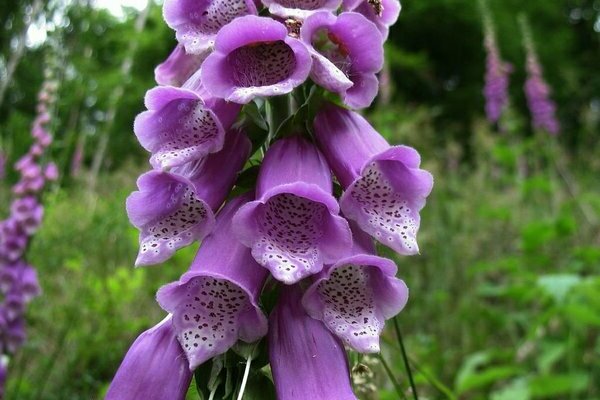
Foxglove: Photo of a plant
Digitalis can be grown by seedling. Sowing for seedlings is scheduled for about the second half of March. In this case, the seeds should be soaked in advance. To do this, they are carefully poured with water at room temperature and the water is changed every five to six hours so that harmful bacteria and microelements do not begin to multiply in it.
The duration of soaking is a week, and if you follow all the rules, especially with a change of water, then the seeds will be ready. They are distributed over the very surface of the soil mixture, and then sprinkled with a very thin layer of sand. The container on top should be covered with either glass or plastic wrap, and it should also be removed to a warmer place, where the lighting will be stable, diffused and very soft.
Seedlings may begin to emerge about two weeks after the seeds have been sown in the container. At first, it may seem to the gardener that the seedlings develop very slowly, or do not give any result in growth and development at all. But this is only a general impression. Then, when the very first true leaf plates form at the seedlings, the plant will already be ready to pick off the plantings.
They are seated either in separate cups, or in containers that are larger in size than the previous ones. And between the seedlings, a distance of seven to ten centimeters is observed. Caring for foxglove seedlings is incredibly easy. It is enough to water it regularly as the soil mixture dries up a little, and also slightly loosen the substrate after each watering.
Also, the seedlings must be protected from drafts, from strong winds and from direct sunlight. Otherwise, this will lead to the fact that the condition of the seedlings will deteriorate and, as a result, they simply will not be able to develop normally further.
About two weeks before the foxglove is sent to the open ground, the seedlings should be hardened. Thanks to these procedures, the plant adapts much faster to the conditions of open ground, to the conditions of the garden. To do this, daily containers with seedlings are taken out to the balcony or loggia, and you can also take out the seedlings directly to the street.
The duration of the procedure must be constantly increased, and the planting of a plant in open ground is prescribed after they can be in the fresh air for days, and at the same time do not react at all to such changes in air temperature, in the general climate. This will mean that the plant has finally adapted, and therefore it will feel almost completely safe in the open field.
Foxglove: planting in open ground
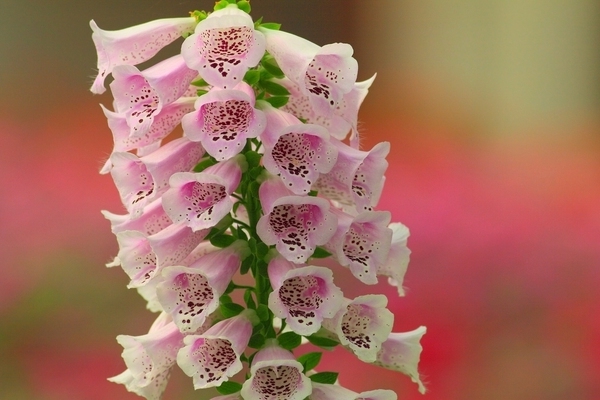
Foxglove: Photo of a plant
In open ground, the plant is planted exactly after the threat of return frosts is minimized. This is especially true in the spring, from the very end of May to the first days of June. Since at this time the weather finally becomes more stable in various regions of our country.
When the time for planting comes, then five to six full-fledged leaves should form on the seedlings. At the same time, the soil should be warmed up well enough for the plant to feel comfortable and safe.
As for the place for the foxglove planting, it should not only be open, but also well lit. But at the same time, it is worth making a reservation right away - digitalis will feel great even in very slight shading. These plants are generally quite resistant to this, so do not worry too much about it if the shadow is suddenly formed.
The site, which is located under the trees of the deciduous group, is not at all suitable for planting foxgloves. Because in the soil and in the near-trunk circle, moisture accumulates in such trees. She can linger too much, and this does not suit the foxglove herself. The plant can get wet, the root system can begin to rot, and this is already the reason why there is no flowering at all.
Also undesirable for digitalis foliage, which flies from the trees with the onset of autumn. Basically, these conditions are the only requirements on the part of the foxglove. Otherwise, it remains a completely unpretentious and absolutely favorable plant, which will not give the gardener any too unnecessary trouble, and even more so trouble.
The soil for planting digitalis must necessarily be very nutritious and loose, as well as permeable and ventilated. At the same time, moisture in the soil should in no case stagnate, otherwise it can lead to rather sad consequences.
The site should generally be prepared in advance. To do this, it is carefully dug up, the depth is one shovel bayonet. Organic matter is introduced into the soil - either compost or humus is ideal. About one square meter of the dug area will require from four to five kilograms of organic matter.
During the planting of digitalis seedlings, a distance of 15 to 20 centimeters is observed between the bushes. But if the foxglove is planted in several rows, then the distance between the rows should be about thirty centimeters.
When the site is completely ready, holes are made on it. Their size may be slightly larger than the size of the root system formed in the planting materials. Further, the plants from the glasses are very carefully transferred directly into the holes. At the same time, the earthen lump should be safe and sound, since the future state of the plant will largely depend on this.
If the seedlings are located in a common container, then they should be taken out from there very carefully and carefully, as if it were jewelry work. And then, along with the soil, the seedlings are placed already in the prepared holes.
When the foxglove is planted in open ground, the surface of the soil should be lightly tamped with your palms, while the plants are moistened with warm settled or filtered water.
In the first year, the foxglove will develop a stable leaf rosette. And the first flowering will come only next season, so you should be patient so that the plant gains strength and gives an excellent decorative result.
Of course, a lot depends only on the gardener himself, so he should be extremely careful and careful in his work, and then the plant will feel safe, will demonstrate excellent results of growth, development and flowering.
Basic care measures
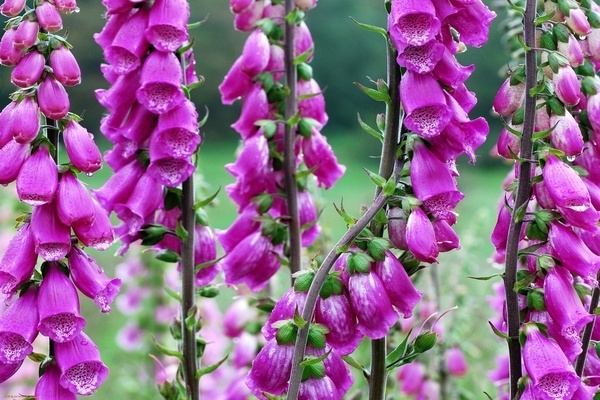
Foxglove: Photo of a plant
In garden conditions, foxglove is grown in exactly the same way as many other crops intended for garden planting. The flower must sometimes be weeded, the soil around it must be loosened, weeds must be removed, and the plant must also be given timely moisture, top dressing, and the bushes must be treated against possible pests or diseases.This is usually done either in accordance with the drawn up plan, or as needed, but in no case should you forget about these activities.
To water foxglove stands only when arid and excessively dry weather is established. If it rains regularly in the summer, then the plant as a whole can do without additional moisture. When the rain has passed or the plant is watered, the trunk circle is recommended very carefully loosen up... Moreover, loosening should not be to a great depth, but light.
The foxglove root system is horizontal, and for this reason it is located very, very close to the soil surface. So you should be very careful when loosening, because there is a high risk of touching the root system and causing multiple mechanical damage to it.
Throughout the growing season feeding should be carried out either once or twice, it all depends on the general state of the planting. The same mineral complexes and fertilizers in liquid form are used for feeding, as for many other horticultural crops.
A solution of minerals should be mixed with water, and then watered with the resulting mixture. In order for the flowering to last longer than the stated period, and the bushes remain the same spectacular and decorative until autumn, it is worthwhile to promptly cut off those branches that have had time to wither or dry out.
It is also worth removing inflorescences that are already withering. Because of them, the plant can no longer function normally. They take away some vitality and energy from him, and this in a special way affects just the external characteristics of the foxglove, on its upper, ground, rather decorative part.
Transfer - the process is quite simple, because the foxglove root system has a horizontal position, and it is not so difficult to extract it from the soil. The bush is carefully dug out of the soil, then placed in a hole that was prepared in advance. In this case, it is best to make the size of the new hole larger than the root system of the plant. Since he will need to grow somewhere further, which means there should be at least a little space, but more.
When the bushes are finally transplanted, they need to be watered very carefully, and this will mean that the transplanting procedure is complete. As you can see, there is nothing complicated about this, especially if you follow the most elementary rules of agricultural technology.
Diseases and pests
Most often, foxglove suffers from spotting, as well as viral mosaics, rot and powdery mildew. If the bush is very much affected by spotting, and the gardener did not notice it immediately, and also if all the symptoms of powdery mildew were found on the bush, then this bush should be dug from the site and burned. And the plants remaining on the site should be treated with a solution based on fungicides, preparing it in accordance with the instructions.
It is also worth remembering that viral diseases such as mosaic, rotting of peduncles, root rot are diseases that cannot be treated at all. Therefore, the bushes are also removed from the soil and destroyed so that the disease does not continue to spread.

Foxglove: Photo of a plant
Also, foxglove can be chosen by different types of aphids. In principle, you can get rid of it. To do this, the plant should be treated with drugs such as Antitlin, Biotlin or Spark, since they are considered the most effective and at the same time quite budgetary means in modern gardening and floriculture.
Also, the gardener needs to keep in mind that sucking insects, like aphids, are a carrier of very dangerous viruses and fungi, so aphids should be dealt with exactly when the gardener noticed the very first signs of its appearance. In general, of course, so that this does not happen, the foxglove must be regularly examined, to monitor any changes occurring in its external characteristics.
It is very important to carry out preventive measures and treatments on time, observe agricultural techniques and caring measures. After all, this is the only way to protect the plant from pests and bacteria and, of course, from diseases.
Preparing for winter
As we have already said, the foxglove root system is located quite close to the very surface of the soil, and in this regard, there are situations when the roots can simply be bare, exposed. If this happened, then in the autumn period, the exposed roots should be sprinkled with fertile soil, and then the plant will not suffer during wintering.
Perennials of this genus, as well as perennial varieties, are distinguished by the fact that they have a high level of frost resistance. But if suddenly the winter is cold, but completely non-snowy, then there is a great risk that the flower will simply freeze out.
When the peduncles begin to gradually lose their color saturation, turn yellow, wither, this suggests that it would be better to cut them off altogether. The rosette is covered with sawdust or straw, spruce branches or leaves that have already dried. While the bushes are still young, they should definitely be covered for the winter. Otherwise, there is a great risk that they will simply die, or be damaged so much that they will lose their decorative features and certainly will no longer bloom, as they did before.
How foxglove reproduces
You can propagate foxglove using seed (this method differs into seedling and seedless, it is understandable why), and you can also multiply digitalis thanks to the overgrown root offshoots.

Foxglove: Photo of a plant
How to grow foxglove in a seedling way and plant it in the ground, we have already described a little higher. But there is also an opinion of experienced gardeners that it is easier to grow a foxglove. reckless way... In this case, send the seeds directly to the open ground.
Seeds are sown in open ground in spring, or at the very end of April, or in early May. Before sowing, the seeds undergo the same preparation as if we were preparing them for growing seedlings in containers. They are soaked for a week, every six hours the water is changed to fresh.
On the surface, the seeds are placed in such a way that a distance of twenty centimeters is maintained between them, no more. The seeds themselves do not need to be buried; they can be slightly sprinkled with a very thin layer of soil.
If the spring is very cool, then the crops can be covered using agrofibre or lutrasil, which is sold in specialized stores for gardeners. If the seedlings turned out to be very dense, then they can be very carefully thinned out, the rosettes will then turn out to be even larger, and in the future the plant will reproduce in such a way as self-seeding. In principle, self-sowing features are sometimes the most beneficial, since the gardener saves a significant part of his time, and focuses on this as a positive characteristic of the plant.
After about three weeks, several small basal tines may grow at the base of the cut peduncles. After the number of outlets reaches eight leaf plates, they should be very carefully separated and transplanted to a completely new place, where they will develop in the future.
The shoots will take root even before autumn comes, and then they will be quite stable both in front of winter adversities and in front of various temperature extremes. Already with the onset of the next season, it will be possible to observe how abundant flower stalks grow and how the plant blooms.In addition, the traits and characteristics of the parent plant are fully preserved, which is also, of course, very important.
Perennial digitalis: species and varieties
Below we will give a description of some species and varieties of foxglove, which today are especially popular among gardeners and florists, as well as which are cultivated most often, therefore they are well studied.
Foxglove purple
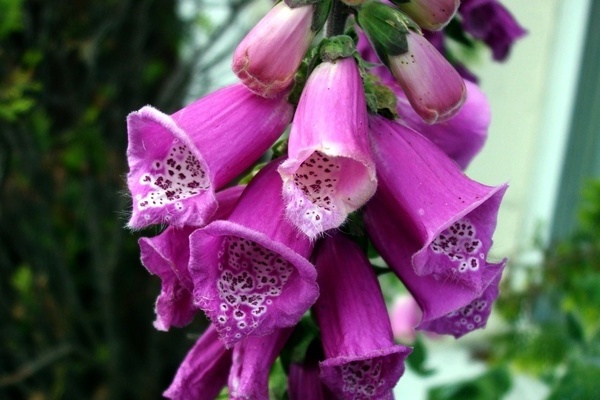
Digitalis purple: Photo of a plant
Its homeland is considered to be Europe - South, Central and Western. This plant belongs to the category of perennials, and more often it is still cultivated as a biennial. The height of this foxglove species is approximately one and a half meters.
Very slight pubescence can be seen on the surface of the standing shoots. The rosette consists of basal leaf plates, it looks very interesting and original. The upper leaves are elongated; very slight pubescence can also be found on them.
The bloom is racemose, one-sided, reaches almost 80 centimeters in length, consists of large flowers that can be painted in different shades - there are cream and carmine, pink and white flowers, and you can even notice purple inflorescences. There is a decorative dark brushstroke inside the corolla, and very small hairs are located on the surface. Flowering is very long, you can enjoy it all summer, and even longer. This species has been cultivated since very ancient times, so it is considered one of the most studied, and this is really very important.
This species has several varieties that are also worthy of attention - these are spotted, large-flowered, gloxiniform. Of all the listed hybrid varieties, the most interesting is the gloxiniform, namely the variety Shirley... The height of the bush reaches one and a half meters, the flowering is very long and attractive, the inflorescences are one-sided, consist mainly of drooping, open flowers with a spotted color, inside they have a purple hue, pink or cream color, much depends on the region in which this variety grows, and how a gardener looks after him.
There is another popular hybrid mix called Excelsior - peduncles reach almost two meters in length, on average - 180 centimeters. The flowers are very large, they are placed on the peduncle in a straight spiral, which looks very interesting.
Another popular mix is Peloric... The height of the peduncle also averages 180 centimeters. At the same time, large flowers are also located on it - they are literally covered with them. The variety is one-color, selective, also called Rosé Champagne. Its height usually ranges from one meter to 120 centimeters, its appearance is very effective, worthy of the attention of gardeners. In addition, the variety is completely unpretentious, so that with the least time and physical costs, you can get a plant that will delight the eye of absolutely any grower.
Foxglove large-flowered

Large-flowered foxglove: Photo of a plant
If you want to meet this species in its natural conditions, then you should go to Western Europe. You can also find large-flowered foxglove in the European part of our country, in Ukraine and the Mediterranean.
The height of this species is no more than 120 centimeters, the leaves are oblong, lanceolate, have very slight pubescence. The pubescence is located on the veins, as well as along the edge of the leaflet. Drooping racemose inflorescences, they consist of flowers, which are about six centimeters long, painted in a bright yellow tint. There are pronounced brown veins inside the corolla itself.
The outer surface of the flower is also covered with very slight pubescence, all this looks really very interesting and attractive. The cultivation of this species began around 1561, and therefore the species has also been fairly studied.He really enjoys incredible popularity, so you should pay attention to him, because this plant can be a decoration of any site.
Foxglove rusty
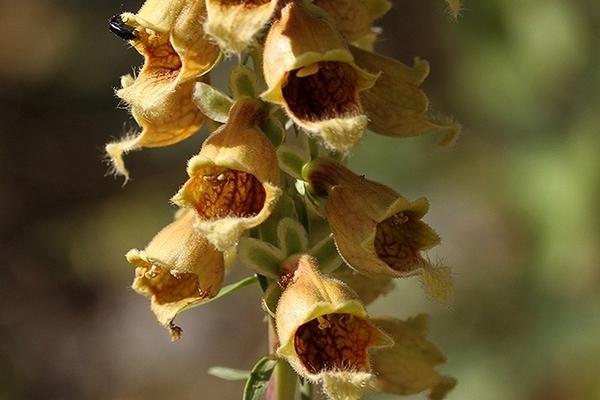
Rusty foxglove: Photo of a plant
This is one of the most attractive and beautiful views you will ever meet. The height of the bush can be different - it can be 70 centimeters, and it can reach 120 centimeters. There are also such specimens that reach a height of two meters and look very neat at the same time.
Leaves can be either bare or slightly pubescent, oblong, lanceolate. The flowers are about four centimeters long, more like an orchid in shape. At the same time, their lower lip is even more pronounced, and, of course, it stands out very much. The flowers are painted in a variety of shades. These are yellowish-gray, which turns into a rusty golden hue, and yellowish with a pink tinge.
In any case, the plants look very attractive, and the inflorescences, due to the color, are quite unusual. The inner surface of the corolla is covered with veins, which can be colored either brown, or reddish, or lilac.
Flowers of this species are part of large racemose inflorescences, while looking extremely decorative and attractive. They really catch the eyes of many gardeners and visitors to their backyard plots.
Flowering begins in mid-June and lasts until about August, and the cultivation of this species began at the end of the 16th century. Now enough information is known about him, and due to this, the plant is also a welcome guest on any site. It is easy to take care of him, receiving in return just wonderful decorative inflorescences and the same attractive shrubs.
Foxglove woolly
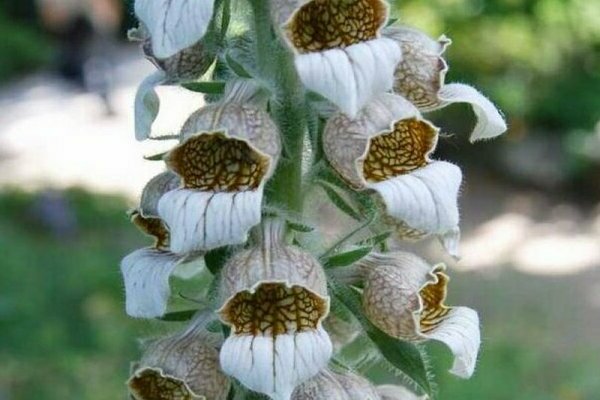
Woolly digitalis: Photo of a plant
This species, even though it is cultivated, unlike all the others, is rather plain. In the wild, most often the woolly foxglove can be found in Moldova. The plant is largely grown for its medicinal properties. And at the same time, of course, it also has some other positive characteristics that simply cannot be ignored.
The peduncle of the plant is single, rather small flowers bloom on it, which are painted in a yellowish-brown hue, and thin purple veins can also be seen on the petals.
The entire axis of the inflorescence is covered with a very dense pubescence, and the name of this type of foxglove is precisely connected with this characteristic feature. The plant begins to bloom in July and lasts for about a month and a half. The flowering is stable and interesting enough. Still, the plant is popular precisely because of its medicinal properties, and not because it may look a little more elegant than some other standard garden plantings.
Foxglove yellow

Foxglove yellow: Photo of a plant
Under natural conditions, this species is more common in the southwestern part of the European continent. The height of the bush varies from 80 centimeters to one meter. There is no pubescence on the shoots, just like on the oblong or oval leaves.
The flowers, according to the name, are colored yellow, their length is about 2.5 centimeters. The flowering itself begins a little later than in other species - in July. The plant has also been cultivated since the end of the 16th century, the most popular of the entire varietal line of this species is the variety called Gelb Janus - the color of his flowers is yellowish, and the plant itself is completely unpretentious, so that it can survive and show its decorative maximum even where, in principle, there are initially no outstanding conditions for this plant.
Also, such types of digitalis are cultivated as dark (unclear), Tapsi and Merton, Nevada foxglove, ciliate and some other forms and species that belong to the category of hybrid. They all differ from each other in size and shape, but each can attract the gardener with something that he has been looking for in plantings for so long to decorate his plot.
Useful properties of digitalis and harm

Since ancient times, many healers and doctors have used foxglove to treat diseases of the chest and abdominal cavities. And also foxglove helped perfectly with dropsy and epilepsy. With the help of it, it was possible to soothe pain, especially if a person suffered from skin diseases.
Foxglove also coped well with intestinal obstruction and cleansed the human body. But nevertheless, if suddenly the doctor or the person himself incorrectly calculated the dosage, this led to the fact that the person could be provoked into poisoning, vomiting and diarrhea began. Sometimes deaths were also observed from this, albeit quite rarely, but they did happen.
Since about the 18th century, foxglove has been used as an element of traditional medicine. At this time, even more unusual properties of this plant were already found. For example, leaves were the most useful medicinal raw material. They included a huge amount of trace elements, vitamins, which also coexisted with biologically active substances. And in the aggregate, they had an incredibly positive effect directly on the human body if it was struck by some kind of disease.
Digitalis was used to strengthen the vascular walls, improve the blood supply to muscles and tissues, normalize the hemodynamics of the body, get rid of cardiosclerosis, as well as atrial fibrillation, which could appear in a person even at a very young age, and this disease is one of the most dangerous.
Usually, to obtain medicinal raw materials, they use woolly digitalis... Sufficient organic acids and microelements can be extracted from the plant. And foliage is used to make powder, which is added in the manufacture of candles and tablets.
In alternative medicine, a tincture from this very plant is most often used, which has many positive properties and components.
Of course, do not forget that foxglove also includes poisons that can be dangerous to life and health, but only if the person himself thoughtlessly uses this plant and does not comply with any norms. Self-medication with this plant is also completely excluded. After all, if it is wrong to extract useful substances from it, then the foxglove can literally kill a person.

